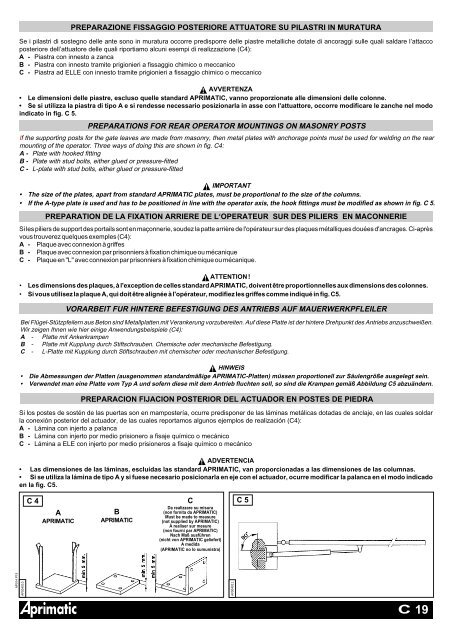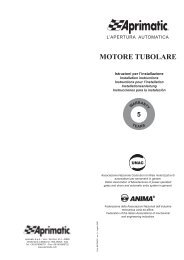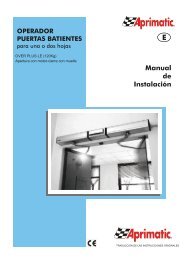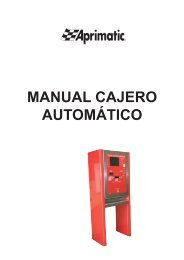OPERATORE OLEODINAMICO PER CANCELLI AD ... - Aprimatic
OPERATORE OLEODINAMICO PER CANCELLI AD ... - Aprimatic
OPERATORE OLEODINAMICO PER CANCELLI AD ... - Aprimatic
Create successful ePaper yourself
Turn your PDF publications into a flip-book with our unique Google optimized e-Paper software.
AP014 P19<br />
PREPARAZIONE FISSAGGIO POSTERIORE ATTUATORE SU PILASTRI IN MURATURA<br />
Se i pilastri di sostegno delle ante sono in muratura occorre predisporre delle piastre metalliche dotate di ancoraggi sulle quali saldare l’attacco<br />
posteriore dell’attuatore delle quali riportiamo alcuni esempi di realizzazione (C4):<br />
A - Piastra con innesto a zanca<br />
B - Piastra con innesto tramite prigionieri a fissaggio chimico o meccanico<br />
C - Piastra ad ELLE con innesto tramite prigionieri a fissaggio chimico o meccanico<br />
AVVERTENZA<br />
• Le dimensioni delle piastre, escluso quelle standard APRIMATIC, vanno proporzionate alle dimensioni delle colonne.<br />
• Se si utilizza la piastra di tipo A e si rendesse necessario posizionarla in asse con l'attuattore, occorre modificare le zanche nel modo<br />
indicato in fig. C 5.<br />
PREPARATIONS FOR REAR O<strong>PER</strong>ATOR MOUNTINGS ON MASONRY POSTS<br />
If the supporting posts for the gate leaves are made from masonry, then metal plates with anchorage points must be used for welding on the rear<br />
mounting of the operator. Three ways of doing this are shown in fig. C4:<br />
A- Plate with hooked fitting<br />
B- Plate with stud bolts, either glued or pressure-fitted<br />
C- L-plate with stud bolts, either glued or pressure-fitted<br />
IMPORTANT<br />
• The size of the plates, apart from standard APRIMATIC plates, must be proportional to the size of the columns.<br />
• If the A-type plate is used and has to be positioned in line with the operator axis, the hook fittings must be modified as shown in fig. C 5.<br />
PREPARATION DE LA FIXATION ARRIERE DE L‘O<strong>PER</strong>ATEUR SUR DES PILIERS EN MACONNERIE<br />
Si les piliers de support des portails sont en maçonnerie, soudez la patte arrière de l'opérateur sur des plaques métalliques douées d'ancrages. Ci-après<br />
vous trouverez quelques exemples (C4):<br />
A - Plaque avec connexion à griffes<br />
B - Plaque avec connexion par prisonniers à fixation chimique ou mécanique<br />
C - Plaque en "L" avec connexion par prisonniers à fixation chimique ou mécanique.<br />
ATTENTION !<br />
• Les dimensions des plaques, à l'exception de celles standard APRIMATIC, doivent être proportionnelles aux dimensions des colonnes.<br />
• Si vous utilisez la plaque A, qui doit être alignée à l'opérateur, modifiez les griffes comme indiqué in fig. C5.<br />
VORARBEIT FUR HINTERE BEFESTIGUNG DES ANTRIEBS AUF MAUERWERKPFLEILER<br />
Bei Flügel-Stützpfeilern aus Beton sind Metallplatten mit Verankerung vorzubereiten. Auf diese Platte ist der hintere Drehpunkt des Antriebs anzuschweißen.<br />
Wir zeigen Ihnen wie hier einige Anwendungsbeispiele (C4):<br />
A - Platte mit Ankerkrampen<br />
B - Platte mit Kupplung durch Stiftschrauben. Chemische oder mechanische Befestigung.<br />
C - L-Platte mit Kupplung durch Stiftschrauben mit chemischer oder mechanischer Befestigung.<br />
HINWEIS<br />
• Die Abmessungen der Platten (ausgenommen standardmäßige APRIMATIC-Platten) müssen proportionell zur Säulengröße ausgelegt sein.<br />
• Verwendet man eine Platte vom Typ A und sofern diese mit dem Antrieb fluchten soll, so sind die Krampen gemäß Abbildung C5 abzuändern.<br />
PREPARACION FIJACION POSTERIOR DEL ACTU<strong>AD</strong>OR EN POSTES DE PIEDRA<br />
Si los postes de sostén de las puertas son en mampostería, ocurre predisponer de las láminas metálicas dotadas de anclaje, en las cuales soldar<br />
la conexión posterior del actuador, de las cuales reportamos algunos ejemplos de realización (C4):<br />
A - Lámina con injerto a palanca<br />
B - Lámina con injerto por medio prisionero a fisaje químico o mecánico<br />
C - Lámina a ELE con injerto por medio prisioneros a fisaje químico o mecánico<br />
<strong>AD</strong>VERTENCIA<br />
• Las dimensiones de las láminas, escluídas las standard APRIMATIC, van proporcionadas a las dimensiones de las columnas.<br />
• Si se utiliza la lámina de tipo A y si fuese necesario posicionarla en eje con el actuador, ocurre modificar la palanca en el modo indicado<br />
en la fig. C5.<br />
AP004010<br />
C 4<br />
A<br />
APRIMATIC<br />
B<br />
APRIMATIC<br />
C<br />
Da realizzare su misura<br />
(non fornita da APRIMATIC)<br />
Must be made to measure<br />
(not supplied by APRIMATIC)<br />
Á realiser sur mesure<br />
(non fourni par APRIMATIC)<br />
Nach Maß ausführen<br />
(nicht von APRIMATIC geliefert)<br />
A medida<br />
(APRIMATIC no lo sumunistra)<br />
AP004011<br />
C 5<br />
C 19





